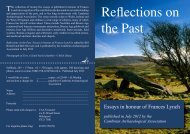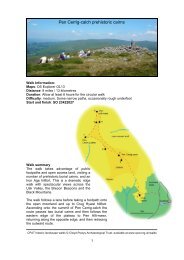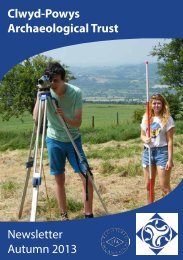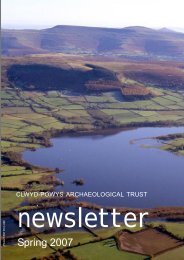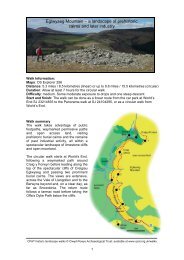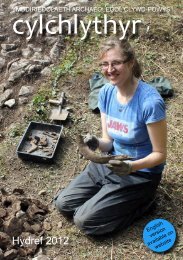28 <strong>Datganiad</strong> <strong>Cadwraeth</strong> <strong>Clawdd</strong> <strong>Offa</strong><strong>Offa</strong>'s <strong>Dyke</strong> <strong>Conservation</strong> Statement 28<strong>Clawdd</strong> <strong>Offa</strong> yn nhirwedd heddiw5.5 Yr hyn sy’n amlwg o’r corff hwn o ymchwil ddiweddaryw, tra bo <strong>Clawdd</strong> <strong>Offa</strong> wastad wedi bod yn rhan o dirweddsy’n datblygu mewn modd sydd, yn anochel, wedi arwain atryw gymaint o ddifrod parhaus iddo, mae’r henebyn heddiw —ar y cyd â nifer o elfennau eraill yr amgylchfyd hanesyddol —yn wynebu mwy o bwysau ar ei oroesiad hirdymor nag erioedo’r blaen.5.6 Mae’r sefyllfa hon yn achosi pryder arbennig, yn amloherwydd bod effaith gronnol colledion blaenorol wedi dod â’rclawdd i drothwy critigol lle mae ei gymeriad craidd a’i integreddfel nodwedd unionlin ystyrlon a gweledol eisoes wedi ei beryglui bwynt lle na ellir ymdopi â dirywiad pellach yn hawdd.5.7 Mae dirywiad y clawdd yn gyffredinol yn deillio o ystodo achosion penodol; y prif bwnc ar hyn o bryd ywgweithgaredd amaethyddol yn arwain at erydu ar 34% o’rclawdd yng Nghymru (Burnham 1992). Mae problemau eraill anodwyd yng Nghymru — erydiad llwybrau (4%), rheolicoetiroedd (6%), tyrchu (2%) a datblygiad (8%) yn ymddangosyn llai arwyddocaol o ran canran y clawdd yr effeithir arno, ondyn amlwg gall fod yn ddifrifol iawn mewn cyd-destun lleol, fel ymae achos Swydd Gaerloyw yn dangos yn glir (Hoyle aVallender 1997) ac fel y mae arolwg a gysylltwyd yn benodol âLlwybr <strong>Clawdd</strong> <strong>Offa</strong> hefyd wedi dangos (Cutts 1998).<strong>Offa</strong>’s <strong>Dyke</strong> in today’s landscape5.5 What is evident through this body of recent research isthat, while <strong>Offa</strong>’s <strong>Dyke</strong> has always been part of an evolvinglandscape in a way which has inevitably resulted in a certainamount of ongoing damage to it, the monument today — incommon with many other components of the historicenvironment — faces greater pressures on its long termsurvival than ever before.5.6 This situation is particularly worrying simply because thecumulative effect of previous loss has brought the dyke to acritical threshold where its core character and integrity as acoherent and visible linear feature is already compromised tothe point where further degradation cannot be lightly absorbed.5.7 The general deterioration of the dyke is the result of arange of specific causes; the principal identified issue at thepresent time is agricultural activity resulting in erosion on 34%of the dyke in Wales (Burnham 1992). Other problems noted inWales — path erosion (4%), woodland management (6%),burrowing (2%) and development (8%) appear less significantin terms of the percentage amount of dyke affected, but canclearly be very serious in local circumstances, as theGloucestershire case in particular demonstrates (Hoyle andVallender 1997) and as survey linked specifically to the <strong>Offa</strong>’s<strong>Dyke</strong> Path has also shown (Cutts 1998).Rheoli glaswelltir5.8 Mae gorbori yn beth cyffredin iawn ar Glawdd <strong>Offa</strong>, ynarwain at golli gwair ar rannau o’r gwrthglawdd, ac yna erydiadgweithredol ac, yn nodweddiadol iawn, tyllau y mae anifeiliaidyn eu ffurfio sy’n gallu tyfu i faint difrifol.5.9 Gall difrod ‘pori’, mewn gwirionedd, adlewyrchu patrwmcymhleth o achosion. Mae’r rhain yn cynnwys effaith sychder ary clawdd, cysgod coed neu brysgwydd a chywasgiad a achosirgan draed anifeiliaid. Rhan o’r broblem yw tuedd naturiolanifeiliaid i ymgasglu ar y clawdd (sy’n cynnig llwybr sych ardraws caeau a lle da i gysgodi) sydd o ganlyniad yn creu lefelauuwch o weithgaredd anifeiliaid ar y gwrthglawdd nag a fyddailefelau ymddangosiadol stocio caeau yn ei awgrymu.5.10 Gall patrymau pori penodol — er enghraifft gaeafuanifeiliaid (gwartheg yn enwedig) — waethygu erydiad, ac maehefyd yn amlwg bod amodau hinsawdd eithafol weithiau ynysgogiad penodol ar gyfer dirywiad glaswellt sy’n datblygu amy tro cyntaf (Berry 2000). Gall ffactorau eraill, megis dodimannau bwydo neu ffynonellau d@r ar y clawdd,ganolbwyntio pwysau anifeiliaid domestig ar y gwrthglawdd.Grassland management issues5.8 Over-grazing is a common issue on <strong>Offa</strong>’s <strong>Dyke</strong>, resultingin loss of grass cover on areas of the earthwork followed byactive erosion and very typically the formation of animalscrapes which can reach serious proportions.5.9 ‘Grazing’ damage may in fact reflect a complex pattern ofcauses. These include drought effects on the dyke bank,shading by trees or scrub and compaction caused by animaltrampling. Part of the problem is the natural tendency ofanimals to congregate on the dyke (which typically affords adry cross field path and a good place to shelter) consequentlycreating higher levels of animal activity on the earthwork thanapparent field stocking levels might suggest would be the case.5.10 Particular patterns of grazing — for example overwinteringof animals (especially cattle) — can increase theseverity of erosion, and it is also evident that extreme climaticconditions are sometimes a specific trigger for swarddeterioration to first develop (Berry 2000). Other factors, suchas placing feeding stations or water sources on the dyke, canfurther concentrate domestic animal pressure on the earthwork.
29 <strong>Datganiad</strong> <strong>Cadwraeth</strong> <strong>Clawdd</strong> <strong>Offa</strong><strong>Offa</strong>'s <strong>Dyke</strong> <strong>Conservation</strong> Statement 29Rheolaeth amaethyddol gyffredinol5.11 Mae’r clawdd yn destun pwysau erydiad beunyddiolarall yn y dirwedd amaethyddol. Mae niwed gan aradr weithiaui’w weld, fel rheol yn gysylltiedig â’r duedd i aredig yn galedyn erbyn y gwrthglawdd gweledol lle mae caeau âr yn cyffinio.Mae symud cerbydau trymion ar y clawdd neu drosto yn gallucael effaith negyddol amlwg, yn enwedig lle mae llinell yclawdd ei hunan yn cael ei defnyddio fel trac mynediad, neu osyw’n agos at brif lidiart cae.5.12 Mae lleoliad aml y clawdd fel nodwedd ar ymyl caeyn ei wneud yn fan lle mae offer yn cael ei storio neu eiadael, ac mae hyn yn gallu tueddu i leihau gwerth weledol ygwrthgloddiau, a chynyddu tebygolrwydd mwy o ddifrod.Gall gosod isadeiledd ffermio — ffensys, llidiardau, draeniauac ati — hefyd fod yn gysylltiedig â dirywiad cronnolffabrig yr henebyn.General agricultural management issues5.11 The dyke is subject to many other kinds of day to dayerosion pressure in the agricultural landscape. Plough damageis sometimes evident, usually associated with the tendency toplough hard against the visible earthwork where it is adjoinedby arable fields. Movement of heavy vehicles on or over thedyke can have an obvious negative impact, especially wherethe line of the dyke is itself in use as an access track or isclose to a main field gateway.5.12 The frequent location of the dyke as a field edge featuremakes it a place where localised dumping or equipment storageoften takes place, and this can tend to reduce the perceivedvalue of the earthworks, and increase the likelihood of otherdamage episodes. Installation of farming infrastructure —fences, gateways, drainage etc — may also be associated withcumulative degradation of the monument fabric.Coetir a phrysgwydd5.13 Mae llawer o’r clawdd wedi ei gytrefu gan brysgwydd,wedi ei blannu yn fwriadol fel gwrych, neu bellach yn bodolimewn coetiroedd o wahanol fathau.5.14 Mae coed/prysgwydd o’r fath yn tueddu i fod yngysylltiedig â thwf llystyfiant gwael, gan greu arwynebau a allfod yn noeth ac agored i niwed. Gall difrod gwreiddiau iorwelion archaeolegol claddedig fod yn ddifrifol, ac mae platiaugwreiddiau coed a gaiff eu cwympo gan y gwynt weithiau ynrhwygo elfen arwyddocaol o arwyneb y clawdd.5.15 Os nad yw gweithgareddau rheoli coetiroedd yn cael eutrefnu yn briodol, gallant ynddynt eu hunain achosi erydiad,yn enwedig mewn cysylltiad â gweithgareddau megis torrigyda pheiriannau cynaeafu mecanyddol, neu lusgo pren dros yclawdd.Woodland and scrub5.13 Much of the dyke has been colonised by scrub,deliberately planted as a hedgerow, or else now exists inwoodland of various kinds.5.14 Such tree/scrub cover tends to be associated with poorground vegetation growth, creating potentially bare andvulnerable surfaces. Root damage to buried archaeologicalhorizons can be severe, and the root plates of wind blowntrees sometimes tear up a significant element of the surfacefabric of the dyke.5.15 If not properly organised, woodland managementoperations may themselves a cause of erosion, particularlyin connection with activities such as felling with amechanical harvester, or dragging cut timber over the dykeearthworks.Anifeiliaid yn tyrchu5.16 Mae cytrefiad aml y clawdd gan anifeiliaid sy’n tyrchu— cwningod a moch coed yn bennaf — yn broblemarwyddocaol ar rai darnau o’r gwrthglawdd, ac mae’n arbennigo ddrwg lle mae’r gwrthglawdd mewn coetir.5.17 Gall gweithgareddau tyrchu achosi difrod mawr iardaloedd cyfyngedig yr henebyn, gyda dinistr tanddaearol oorwelion archaeolegol, cwymp tir, newid yng ngolwg ygwrthglawdd, a chreithio sylweddol a phridd yn symud ar yrarwyneb.Burrowing animals5.16 The frequent colonisation of the dyke by burrowinganimals — principally rabbits and badgers — is a significantproblem on some stretches of the earthwork, and isparticularly prevalent where the earthwork is in woodland.5.17 Burrowing activity can cause massive damage tolocalised areas of the monument, with undergrounddestruction of archaeological horizons, subsidence, change inthe appearance of the earthwork, and substantial surfacescaring and earth displacement.



